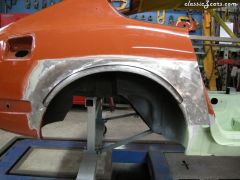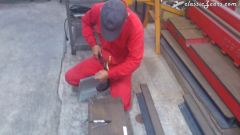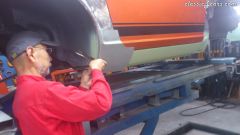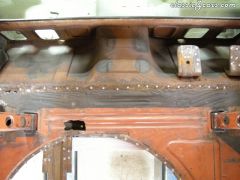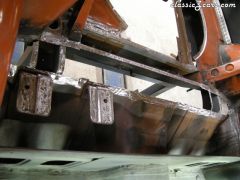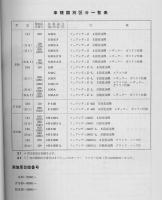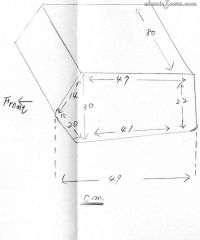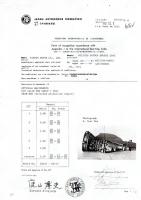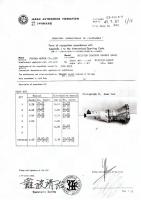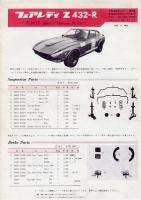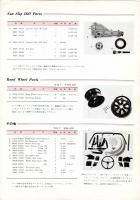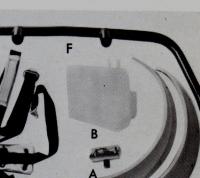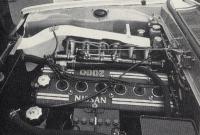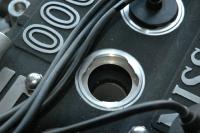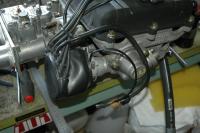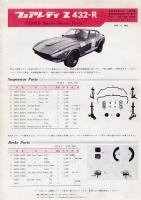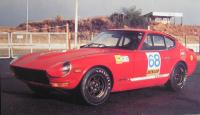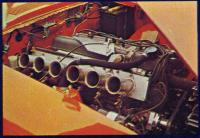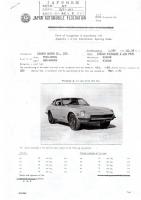Everything posted by HS30-H
-
L-Series engine timeline
Except that it completely ignores the Japanese market L20A and L20AE-engined models. Speechless.....
-
Let's show vintage racing pictures. I'll start.
Look again. The emblems say 'Fairlady 240Z'. Correct factory badging for L24-engined Fairlady 240Z, Fairlady 240Z-L or Fairlady 240ZG.
-
original blue engine paint colorcode?
Do you guys ever use the SEARCH function? We've discussed all this many times before. The original colour had its roots in the Austin-Nissan tie up of the 1950s. The colour is still listed on the 'British Standard' database as B.S. 18C39, with HMG ( Her Majesty's Government ) Glidden number GL31557, and Glidden number name 'Dolphin Blue'. I think a Netherlands-based paint supplier should be able to cross-reference those codes.
-
1970 240z head
You need to be more careful about how you write the transmission codes out. You meant to write FS5W71B and FS5W71C. F5W71B and F5W71C are something else entirely....
-
432R is beautiful; but
-
432R is beautiful; but
-
432R is beautiful; but
-
432R is beautiful; but
-
432R is beautiful; but
-
How rare is an original 5 speed manual 240z?
To be fair, historically the situation was probably pretty much the same outside the US too. However, we've spent lot of time on this forum over the years discussing this very topic and these very terms. It would be nice to think that some of that would have rubbed off, and that people would not be quite so incredulous to hear that an HLS30-prefixed 'Datsun 240Z' might have come from the factory with an FS5C71-A trans and 3.9:1 diff as standard equipment somewhere in the world ( "impossibly rare"....? ). After all, as yourself and 26th-Z have shown, it's all in the factory manuals and service bulletins..... On the subject of suffixes, spare a thought for the Japanese market. In October 1971, there were more prefixes and suffixes attached to the 'S30' series code than you could shake a stick at:
-
How rare is an original 5 speed manual 240z?
I don't want to sound rude, but this is pretty basic stuff we're talking about here.... The north American market 'Datsun 240Z' didn't have a 'U' in its VIN prefix, but it had the 'U' suffix in its factory model variant code. In Japan they called it the 'Katashiki'. For the 'U' suffixed models, there were extra sub-variants depending upon the sales destination. The ful codes were not affixed to the car, and are not to be confused with the full VIN number / body serial number / 'Shatai Bango'. The RHD export 'HS30U' models also didn't have that 'U' in their VIN / body numbers, but it was there in the 'Katashiki' and that's why Haynes - following the example of the factory workshop manuals - put it in their manuals. The 'HLS301' was the LHD export market 'Datsun 240Z' which was manufactured specifically for the mainland European market. It had the FS5C71-A 5-speed transmission as standard equipment ( as did the 'HS30U' ). It was only the north American market cars that didn't get a 5-speed trans as standard equipment. Having said all that, GeoJoe's car - if it's a north American market model - would almost certainly not have been equipped with a 5-speed trans when it left the factory.
-
How rare is an original 5 speed manual 240z?
The Haynes manual is correct*. You guys are just not understanding the differences between an HLS30U and an HLS301 ( or an HS30U ). *Shocking, but true in this case.....
-
432R is beautiful; but
-
432R is beautiful; but
-
all gear sets from FIA 3023
From the left: F4W71A ( fitted to HLS30 / S30-S from Oct. 1969 ) FS5C71A ( fitted to H(L)S30 / S30 / PS30 / PS30-SB from Oct. 1969 ) Then in the middle, the July 1971 amendment with the optional 'Direct-Drive' version of the 71A ( 1:1 fifth gear, 'Dogleg' / 'Low Back' shift pattern ), which was never available as showroom stock equipment on an S30-series Z, but certainly was available as a 'Sports Option' part before the end of 1970. Then on the right the January 1972 amendment with the F4W71B ( fitted to HLS30 / S30-S from October 1971 ) and FS5C71B ( H(L)S30 / S30-S / PS30 from October 1971? ) There were several optional gearsets available for the F5C71B ( 1:1 'Direct Drive' / Dogleg 5-speed ) and FS5C71B ( Overdrive 5-speed ). There are possibly some other pages of the 3023 with relevance to transmissions that might be produced to satisfy road vehicle licensing / legality. Maybe a better way to get what you need might be to identify what you need to establish, and then seek out the data to support it. There are several ways that might get you to where you need to be..... Alan T.
-
all gear sets from FIA 3023
-
Genuine PS30-SB 'Fairlady Z432-R' refresh story in Gallery
Chris, The explanation is that the Parts Catalog lists and illustrates the stock parts for the PZR, and the PZR didn't have the expansion tank as a stock part. The 'Race & Rally Manual' for the PZR ( which is sometimes called the 'Yellow Book' ) shows owners how to modify their PZR for competition use, using many parts from the Sports Options list but also from other models ( including the PGC10 Skyline GT-R ). Please see below a scan of the back page of the Sports Options booklet for the PZR, and a close-up of the 'Reservoir Tank'. This was actually used as a kind of sub-tank / swirl pot in the race prep of the car, holding an amount of fuel drawn from the tank and pumping that up to the carbs. It helped to avoid fuel starvation due to slosh in that 100 litre main tank. The part numbers are actually different in the 'Yellow Book' and the Sports Options list, and the illustration in the Sports Options list looks a little different to the stock vapour tank, and it may have been the case that both were used. But I think the vapour recovery tank you see on your cars was very similar ( although it had more hose connections ), and I've seen these vapour recovery tank used as a sub-tank in this way. Main reason is that it's a lovely purpose-built snug fit in that right inner quarter area, and is fuel safe. Alan T.
-
Genuine PS30-SB 'Fairlady Z432-R' refresh story in Gallery
Hi Kats, Yes, Nissan were using the metal plug cap retainers on the works PGC10 and KPGC10 Skyline GT-R race cars too. They are simpler than the version seen on the GRX V12 engine I think. Distributor cap cover was rubber, and primarily intended to keep out rain water. Actually, even though Victory 50 are selling the plug cap retainers, I believe they were reproduced by a good friend of Matsui san ( NP35 ). Cheers, Alan T.
-
Genuine PS30-SB 'Fairlady Z432-R' refresh story in Gallery
Nissan's first official works race Z was something of a star, as it was used for the covers of several 432-R related publications. This was the car that took part in the 'Zen Nihon Suzuka 300km' race at Suzuka Circuit on 18th January 1970, driven by SCCN works team driver Moto Kitano. Sadly, it was to be car's first and last race. Forced to spin to avoid another car blocking the track, Kitano was T-boned by a following car and was lucky to avoid serious injury. The car was a banana-shaped write-off. Pictured: Nissan 'Yellow Book' Race & Rally Manual for the 432-R, front page of the Nissan Sports Options parts list for the 432-R, and the 'no.68' works 432-R race car in the old Suzuka Circuit paddock before that fateful 18th January 1970 race. Alan T.
-
Genuine PS30-SB 'Fairlady Z432-R' refresh story in Gallery
EuroDat, Just to clarify: This thread is primarily about the PS30-SB 'Fairlady Z432-R. The PS30 Fairlady Z432 had the 'normal' Master Vac brake booster and pedal, whilst the PS30-SB Fairlady Z432-R was the one without the Master Vac brake booster, and had a brake pedal with a greater leverage ratio to suit.
-
Genuine PS30-SB 'Fairlady Z432-R' refresh story in Gallery
Hi Ron, I would have thought that anyone ordering a PZR new would have been buying into the whole ethos of the car as a 'spartan', lightweight driver's car. The lightweight body, plastic windows and cloth-covered, non-reclining FRP seats would have been a big part of that and I can only imagine him adding some 'essentials' like the heater/demister for example. I would imagine that he didn't have a choice over whether to go with the lightweight panels ( especially the rear quarters and the roof ) if the PZR-specific bodies were already half made, or if there were a few complete cars already built. Officially there wasn't even a colour choice ( all the cars sold to the general public were 918 orange ) and if a customer wanted a few more bells and whistles he might as well have paid a little bit more and plumped for the 'ordinary' 432 with its 'Deluxe' spec. In the C-236 parts list I can see: 78100-E7200 PANEL arse'Y - rear fender ( R.H. ) - PZR 78100-E8201 PANEL arse'Y - rear fender ( R.H. ) - PZR ( from C/# PS30-00402 ) 78101-E7200 PANEL arse'Y - rear fender ( L.H. ) - PZR 78101-E8201 PANEL arse'Y - rear fender ( L.H. ) - PZR Off the top of my head, I'm thinking that this marks the changeover from solid, unvented rear pillars to the vented rear pillars. If they are for the PZR then they should be the thinner gauge steel pressings, or at least the earliest type would be. As we know from their chassis numbers, the PZRs sold to the genral public were all 'early' cars ( with unvented pillars ) - so perhaps the later part numbers were more a theoretical fitment should a car be ordered at that time...? Interestingly, the works rally 240Zs that were made in the mid to late 1971 period - using much of the PZR's bodyshell pieces - used the solid, unvented PZR rear quarters, but had their pillar vent holes cut out by hand and the vented 'Z' pillar emblems attached ( to make them look more 'up to date' no doubt ). They retained the FRP tailgates complete with twin vents and all the venting paraphernalia inside them. So they ended up with vented quarteers and vented tailgates.
-
Genuine PS30-SB 'Fairlady Z432-R' refresh story in Gallery
The factory Works race team used the Lucas-based sliding throttle mechanical injection on their 432-R race cars almost from the get-go. I think in the first couple of races the cars were still fitted with carburettors ( although Weber 45DCOE-9 as opposed to the stock Mikuni-Solex 44PHH ), but certainly they had followed the Skyline GT-R race cars onto the Lucas mech FI by the time of the PZR's first race win ( April 12th 1970, 'Race De Nippon', Fuji Speedway, Hasemi / Kitano ). Although the Lucas-based mech FI system was not really very sophisticated in today's terms, it did give more outright power than carbs and was more suited to the kind of racing they were doing. The works S20 engines that were built to run the injection system had higher compression ratios, different cams and different timing to suit. It's a big topic of research on it's own, as Nissan were trying new things in almost every race and none of the details were really in the public domain. Of course, the ex-Prince guys at Murayama ( at that time busy building and developing the Skyline GT-R race cars ) considered the S20 to be 'their' engine and it seems they weren't really all that keen on the 432-R getting any particularly trick parts too soon after the GT-Rs. In fact, it was a bit of a strange situation for the Murayama-based group to be prepping the 432-Rs at all; There was a certain amount of competition between the Murayama ( PMCS ) team and the Oppama ( SCCN ) team, and this ultimately hampered the development of the PZR in race guise as it was a little lost between them ( you could say it was an Oppama body with a Murayama engine ). I don't want to talk this up too much, but it did happen and the works 432-R race cars probably could have been better had they not been forced to lag a little behind the works GT-Rs. In the end ( in fact, only mid-way through 1970 ) the decision was made to switch the works circuit race 432-Rs onto L24-based engines and bump them up into a different class of racing that could take advantage of the capacity increase. From then on the Oppama-based works team looked after them. I think induction system was free for the Sports Prototype, GT and Touring Car classes that the works S20 engines were usually competing in ( as long as it was 'normal' aspiration rather than forced / boosted ) and therefore either carbs of FI could be used. There's nothing in the homologation papers with regard to the mechanical injection.
-
Genuine PS30-SB 'Fairlady Z432-R' refresh story in Gallery
It might be something that pains us to see today, but at the time they were not particularly concerned about it. Nissan ran open trumpets on their race and rally engines during this period ( even using simple wire gauze covers on the trumpets for certain international rallies ) and tended to refresh engines between races anyway. As has been discussed, the homologation of the 432-R was all about saving weight and making a good base for further development. The weight saved on the homologation of the PZR ( I think it was homologated at around 960kg ) allowed Nissan and their privateer customers some scope in further lightening their race cars - whilst also adding weight through safety devices etc - and still being 'legal' to race. The stock airbox, ducting and air filter housing for the S20 engine is quite a large and heavy piece and it would have assisted the weight-saving effort to leave it off. Road users could always retro-fit filters if they really wanted them.
-
Genuine PS30-SB 'Fairlady Z432-R' refresh story in Gallery
I just wanted to add a few words about the Race Homologation of the Fairlady Z432 and the Fairlady Z432-R: Homologation is the process which enables an auto manufacturer to legalise its product for use in certain classes of national and international competition. Manufacturers sometimes make a short production run of cars specifically to meet the requirements of a racing class, and such cars are often nicknamed 'Homologation Specials'. Both the Fairlady Z432 and the Fairlady Z432-R were examples of this. Nissan had not intended to race the 432 or 432-R outside Japan ( although it did happen, and perhaps more on that later.... ) so it homologated them with the Japan Automobile Federation. The 432 was initially homologated in JAF's 'GT' class ( with a minimum requirement that 250 identical cars be manufactured within a certain period, and 500 or more in total ) and the 432-R was homologated as an 'evolution' of the 432 in JAF's 'Prototype' class ( with a minimum requirement of 25 identical cars manufactured ). Nissan homologated the L24-engined Datsun 240Z and the L20A-engined Fairlady Z/Z-L with the world motorsport sanctioning body, the FIA ( Federation Internationale de l'Automobile ) with an eye on competition use outside Japan as well as within, but with higher production numbers required. Here's where the inspiration for much of the 432 and 432-R comes in: In 1966, Porsche had introduced their 911S model - a hotted up variant of the 911 aimed at the sporting road user, but also intended to homologate parts and specs that would be a sound basis around which to build competition cars to take part in the FIA's GT classes of racing and rallying. In 1967 Porsche went further, and built a short production run of a super-lightweight evolution of the 911S, and they called it the 911R. Just 24 911Rs were built, allowing Porsche and its customers to enter the car in the Prototype racing class. That letter 'R' stood for 'Rennen' ( Racing ) and the 911R was built for just that: It had front wings ( fenders ), engine cover, front lid, bumpers and dash made from lightweight FRP, whilst its doors were made from alloy. All windows except the 'screen were plexiglass, and that front 'screen was made from thinner glass than the 911S. The rear arches were slightly flared to accommodate 7j wheels, whilst 6j were used at the front. The interior was spartanised with the deletion of items such as the passenger sun visor, clock, rear seat squabs, heater, ashtray and lighter, with two lightweight bucket seats added, a ventilated version for the driver and a more basic plastic item for the passenger. A larger fuel tank was also fitted. The engine and the drivetrain of the 911R were improved over that of the stock 911S, with a magnesium crankcase, forged crank, titanium conrods and twin plug heads with triple 46 IDA Weber carbs. With a 10.3:1 compression ratio this engine was quoted as giving 210bhp at 8000rpm. With the R weighing just 830kg ( the four factory prototypes weighed even less ) they were pretty fast for the period. It seems to me that the Porsche 911R set the standard which Nissan used as some inspiration for the specs - and even the name - of their super-lightweight Z. If the Fairlady Z432 was Nissan's 911S, then the Fairlady Z432-R could be seen as their 911R. Here's a scan of the front page of the JAF homologation papers for the Fairlady Z432: Alan T.
-
Genuine PS30-SB 'Fairlady Z432-R' refresh story in Gallery
I like the "hand built" operation point, as in many respects I keep thinking of these private roadgoing PZRs as something like a bespoke Savile Row suit. And like a bespoke handmade suit, it's quite often the case that what you can't see is the very thing that makes it so special... Hi Chris, Yes, I know what you mean. I've spent many many hours with my head buried in the factory parts lists, trying to make sense of the PZR-specific items and how they were applied so that I could - hopefully - use some of that info for my own replica project. There are quite a few PZR-specific parts that were not in the parts lists, and there are also what appear to be a few mistakes. However, as the PZR was a stripped-out and 'spartan' driver's car, quite a few of the parts used on them were the no-frills 'Z-Std' / 'ZS' / 'S30-S' Fairlady Z stock parts ( as opposed to the deluxe spec 'Z-dx' / 'Z-L' / 'S30' Fairlady Z-L ). I'm thinking of items like the 4.5j steel wheels, the rubber floor mats and the clock aperture blanking plate for example. Which are the parts that fit the PZR, ZS and ZL, but not the 'ordinary' PZ? Generally speaking, it seems logical that some of the ZS-specific parts were used on the PZRs, and that many parts would be used on the PZ as well as the ZS and ( particularly ) the Z-L, and that many parts would be PZR-specific ( brake pedal and BMC, for example ), but parts shared between the ZS, Z-L and PZR but not the PZ I can't think of? What have you spotted? I'm not sure what the "up to 72 model year" ( that would have been the October / November 1971 changeover period ) meant in relation to the PZR either, and wonder if Nissan were just covering the retro-fit replacement parts situation? Always something new to learn about these cars. Cheers, Alan T.





